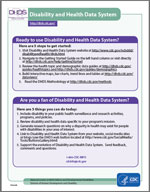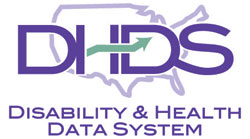Disability and Health Data System
Introducing an Innovative Online Tool to Help States Identify and Compare Health Disparities for People with Disabilities
CDC introduces an online interactive system that quickly helps translate state-level, disability-specific data into valuable public health information. With Disability and Health Data System (DHDS), users can customize how they view disability and health data throughout the country, making it easy to understand health disparity information, identify trends, and help support the development of fiscally-responsible, evidence-based programs, services and policies that include people with disabilities.
DHDS Tip Sheet
What is Disability and Health Data System?
- The first-ever, state-level data system dedicated to disability and health;
- Hosts disability and health data in a central, online location with on-demand access;
- Incorporates user-centered design based on input from state based partners that included public health department employees and researchers;
- Provides customizable views of disability and health data through interactive maps, comparison maps, bar charts, trend lines and tables;
- Uses Behavioral Risk Factor Surveillance System (BRFSS) data from 2004-2010;
- Includes 79 health and demographic indicators stratified by disability status presented as single survey year, 5-year average, and 5-year average stratified by demographic groups;
-
Includes 49 indicators separately stratified by psychological distress for the 2007 single survey year;
DHDS Fact Sheet

- Contains data on disability-associated health care expenditures.
How does Disability and Health Data System work?
- Provides a user with the information to identify differences in health measures between people with disabilities and people without disabilities;
- Provides customized views of disability and health data for all 50 states, District of Columbia, and three territories;
- Displays information on over 79 different health and demographic indicators for people with, and without, disabilities;
- Displays data on psychological distress and disability-associated health care expenditure;
- Compares data by state and/or region on-demand.
Who are users of Disability and Health Data System?
- Academic institutions with interest in disability and health
- CDC programs
- Health care providers
- Health educators
- National disability and health organizations
- Policymakers and staff
- Public health professionals
- Researchers
- State, tribal, local and territorial public health departments
- State-based chronic disease directors
- State-based disability organizations or staff working in disability
Why should organizations use Disability and Health Data System?
- Identifies opportunities to include people with disabilities in programs and policies;
- Provides state-level data to support programs and efficiently allocate resources to improve the health of people with disabilities;
- Identifies health trends and differences in health for people with disabilities;
- Generates research questions to investigate factors that contribute to differences in health experienced by people with differences.
About Disability and Health
There are 1 in 5 Americans living with a disability. Disability is often equated with poor health; however, people with disabilities can and should have the same opportunity for good health as people without disabilities. Compared to people without disabilities, research shows that people with disabilities are more likely to be obese, smoke and have more difficulty accessing preventive health services. In order to reduce the differences in health, state-based data are needed to provide evidence for programs and services that can effectively improve the health of people with disabilities.
About the Division of Human Development and Disability
The Division of Human Development and Disability works to promote optimal human development in children at risk for a disability and to prevent health problems in people who are living with a disability. The division is located in CDC’s National Center on Birth Defects and Developmental Disabilities.
Disability & Health in
Contact Us:
- Centers for Disease Control and Prevention
National Center on Birth Defects and Developmental Disabilities
Division of Human Development and Disability
1600 Clifton Road
MS E-88
Atlanta, GA 30333 - 800-CDC-INFO
(800-232-4636)
TTY: (888) 232-6348
New Hours of Operation
8am-8pm ET/Monday-Friday
Closed Holidays - cdcinfo@cdc.gov



